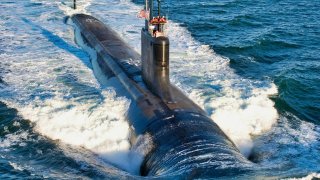UUV Drone Swarms: How the Age of the Submarine Comes to An End?
The U.S. Department of Defense is slow to adapt to modern warfare, focusing on traditional projects instead of innovative technologies like spaceplanes or swarms of unmanned underwater vehicles (UUVs).
Summary and Key Points: The U.S. Department of Defense is slow to adapt to modern warfare, focusing on traditional projects instead of innovative technologies like spaceplanes or swarms of unmanned underwater vehicles (UUVs).
-Despite the proven effectiveness of unmanned aerial vehicles (UAVs), the Pentagon has only recently begun developing UUVs, such as DARPA's Manta Ray.
-These systems are crucial for future conflicts, especially against China in the Indo-Pacific.
-The Navy should integrate UUVs with manned submarines to enhance combat effectiveness. Embracing such advanced technologies is essential for the Pentagon to stay ahead in modern warfare.
Why the Pentagon Needs to Prioritize UUV Swarms Over Legacy Systems
The face of modern warfare is changing at superluminal speeds. Yet the sclerotic, byzantine bureaucracy that is the U.S. Department of Defense is slow on the uptake. Its focus remains on projects such as a new, unnecessary light tank for the Army, or a new aircraft carrier that does not deliver on its promises.
But suggest mass-producing a spaceplane that could actually debilitate China’s anti-access/area-denial (A2/AD) capabilities and they call you a madman. (I know because this has happened to me on more than one occasion. When I worked in government, I was derisively referred to as “the space cadet”).
In a similar vein, the Pentagon is only now starting to investigate the prospect of building swarms of unmanned underwater vehicles and other naval drones to serve as force multipliers. Even then, it is a slow-going process, largely because the Pentagon never prioritized these systems. The department ignored these capabilities even as unmanned aerial vehicles proved their usefulness repeatedly across 20 years of conflict in the Greater Middle East.
Why would the Pentagon not have just assumed that maritime drone systems would be as effective and useful as UAVs? Perhaps because their relative cheapness and simplicity compared to larger manned systems made such capabilities less appealing?
I don’t want to sound too cynical here, though. So, I will note that DARPA has started building and testing larger UUVs like the Manta Ray. Better late than never.
Such systems will prove decisive in any potential conflict between the United States and China in the Indo-Pacific.
Can We Change With the Changing Face of War?
But the war that we fear is coming sooner than later. The hour is late to prepare for it. There are some people who fetishize weapons platforms. The U.S. Navy has a quasi-religious commitment to the aircraft carrier. In the Air Force, the cult of the air offensive pervades all doctrinal concepts. The Space Force is spinning out of orbit as it is left to absorb the noxious gases of DIB initiatives and lack of funding.
The Army, meanwhile, insists that it needs more tanks as it prepares to relive its glory days by investing in systems like the M10 Booker light tank.
It's only really the Marines that are somewhat figuring out what to do in this era of restored great power competition and conflict. But even they are not making the turn quite as effectively as they did when they went from being an amphibious force to being a counterterrorism and counterinsurgency element in the War on Terror.
The Pentagon must make the turn toward actual modern warfare, not the kind of modern warfare that videogame designers or Pentagon dreamers concoct to entertain and enthrall.
This means embracing systems like the X-37B (or at least its concept); building out swarms of UUVs and UAVs to overwhelm any target; developing hypersonic weapons to hold Chinese targets hostage at longer ranges the way that China is doing to the U.S.; and abandoning the government’s blind commitment to increasingly expensive legacy systems that have decreasing returns.
What Role Will UUVs Have?
Looking at the potential of a Sino-American conflict in the Indo-Pacific, two factors must be understood: Submarines will be of increasing importance. And the existence of UUVs will complicate the ability of submarines to conduct operations in contested waters.
There is not, however, enough time for the Navy to just flood the zone with UUVs and forego manned systems entirely. Nor is there time to build enough submarines to restore deterrence.
Instead, the Navy should be arming its submarines with as many UUVs as possible to augment the combat effectiveness of submarines when squaring off against Chinese forces.
Over time, UUVs may make submarines as obsolete as advanced A2/AD capabilities have made many surface warships. But we are not yet at that point. Developing swarms of UUVs to operate in tandem with manned submarines in combat is the way to go.
Does the U.S. military have the leadership and acquisitions bureaucracy capable of making this turn away from the legacy systems and toward cheaper, more effective systems like UUV swarms?
About the Author
Brandon J. Weichert, a National Interest national security analyst, is a former Congressional staffer and geopolitical analyst who is a contributor at The Washington Times, the Asia Times, and The-Pipeline. He is the author of Winning Space: How America Remains a Superpower, Biohacked: China’s Race to Control Life, and The Shadow War: Iran’s Quest for Supremacy. His next book, A Disaster of Our Own Making: How the West Lost Ukraine, is due October 22 from Encounter Books. Weichert can be followed via Twitter @WeTheBrandon.


